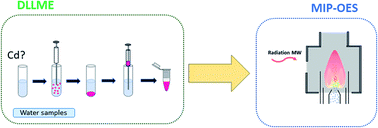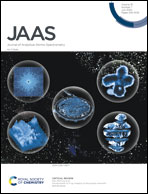Evaluation of MIP-OES as a detector in DLLME procedures: application to Cd determination in water samples†
Abstract
High-power microwave induced plasma optical emission spectrometry (MIP-OES) constitutes a serious alternative to inductively coupled plasma optical emission spectrometry (ICP-OES) for elemental analysis. To improve the analytical capabilities of MIP-OES, dispersive liquid–liquid microextraction (DLLME) procedures seems to be, a priori, a very promising choice for trace and ultra-trace analysis in complex matrices. Nevertheless, to date, DLLME has never been coupled to MIP-OES. The goal of the present work is to investigate the capability of MIP-OES as a detector in DLLME procedures. To this end, spectral and non-spectral interferences caused by the presence of common DLLME extractants (i.e., chloroform and supramolecular solvent based on 1-decanol and THF) in MIP-OES have been evaluated. Results reveal the occurrence of both spectral and non-spectral interferences due to carbon-based molecular bands emission in MIP-OES. Carbon-based molecular emission (i.e. C2 and CH) significantly affects analyte wavelengths above 328 nm. By the appropriate selection of experimental conditions (i.e. analyte wavelength and nebulizer gas flow rate), both spectral and non-spectral interferences could be mitigated allowing elemental analysis by means of DLLME-MIP-OES. Different DLLME methodologies have been developed for Cd determination in water samples (i.e., tap, sparkling and synthetic seawater) by MIP-OES. These methodologies afford an enrichment factor of 46 and 42 for chloroform and supramolecular-based solvent DLLME procedures, respectively, and a limit of detection (LoD) of 1 μg L−1. This LoD is 100-fold lower than that obtained by conventional MIP-OES (i.e. no DLLME) due to both analyte preconcentration and the beneficial effect of organics on aerosol generation and transport. These analytical figures of merit are equivalent to those previously reported for DLLME-ICP-OES and allows Cd determination in water samples according to current international policies.



 Please wait while we load your content...
Please wait while we load your content...